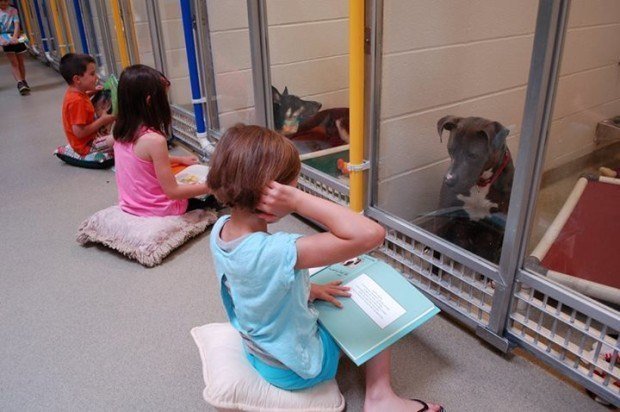
- Inspiring People -
- 3mins -
- 794 views
These children are reading to shelter dogs — with surprising benefits for both animal and child
The innovative Shelter Buddies Reading Program is designed to help shelter dogs become more adoptable. Reading to the dogs helps to bring comfort and reduce anxiety, while nurturing empathy in the children and improving literacy skills.
Children sit outside of the dog’s kennel on a cushion or blanket and read to them
The Shelter Buddies Reading Program was designed to help shelter dogs in Missouri become more adoptable. Reading to the dogs helps to bring comfort, reduce anxiety, gain confidence and grow more comfortable with visitors, and it nurtures empathy in the children while improving their literacy skills. Participants sit outside of the dog’s kennel on a cushion or blanket and read to them.
The children are trained to read a dog’s body language to tell if they are stressed out or anxious
"We wanted to help our shy and fearful dog without forcing physical interaction with them to see the positive effect that could have on them," program director Jo Klepacki told The Dodo.
Children aged between 6 and 15 can sign up for the program online, after which they are trained how to read a dog’s body language to tell if they are stressed out or anxious. Those pets, say Klepacki, are the ones most in need of special attention.
The young volunteers are then encouraged to sit in front of a shy dog’s kennel with a book and read to them – a simple gesture that can go a long way.
"Ideally that shy and fearful dog will approach and show interest. If so, the kids reenforce that behavior by tossing them a treat," said Klepacki. "What this is also doing is to bring the animals to the front in case potential adopters come through. They are more likely to get adopted if they are approaching and interacting, rather than hiding in the back or cowering"
The more timid dogs aren’t the only ones benefiting from the program. High-energy dogs, too, have shown improvements from being read to. "Hearing a child reading can really calm those animals," Klepacki said. "It is incredible, the response we’ve seen in these dogs."
Source: TheDodo

The program has been successful in helping dogs find forever homes
Once a child has completed the 10 hour training program, learning to work with the animals under supervision, they can then come back with their parents any time to sit and read to the dogs.
But while the added practice is no doubt beneficial to them as students, they’re getting something even more important out of it."It’s encouraging children to develop empathy with animals. It’s a peaceful, quiet exercise. They’re seeing fearfulness in these animals, and seeing the positive affect they can have," said Klepacki.
"It encourages them to look at things from an animals perspective. That helps them better connect with animals and people in their lives."
Since the Shelter Buddies Reading Program has been launched, Klepacki says it’s been successful in helping dogs find forever homes. Best of all, children in the area are as excited as anyone about getting involved; sign-ups have been through the roof.
If all goes well, Klepacki hopes to expand the reading program to all of the Humane Society of Missouri’s shelters – and to cats as well."I’m really excited about this program," she said. So are we.
Source: The Dodo


